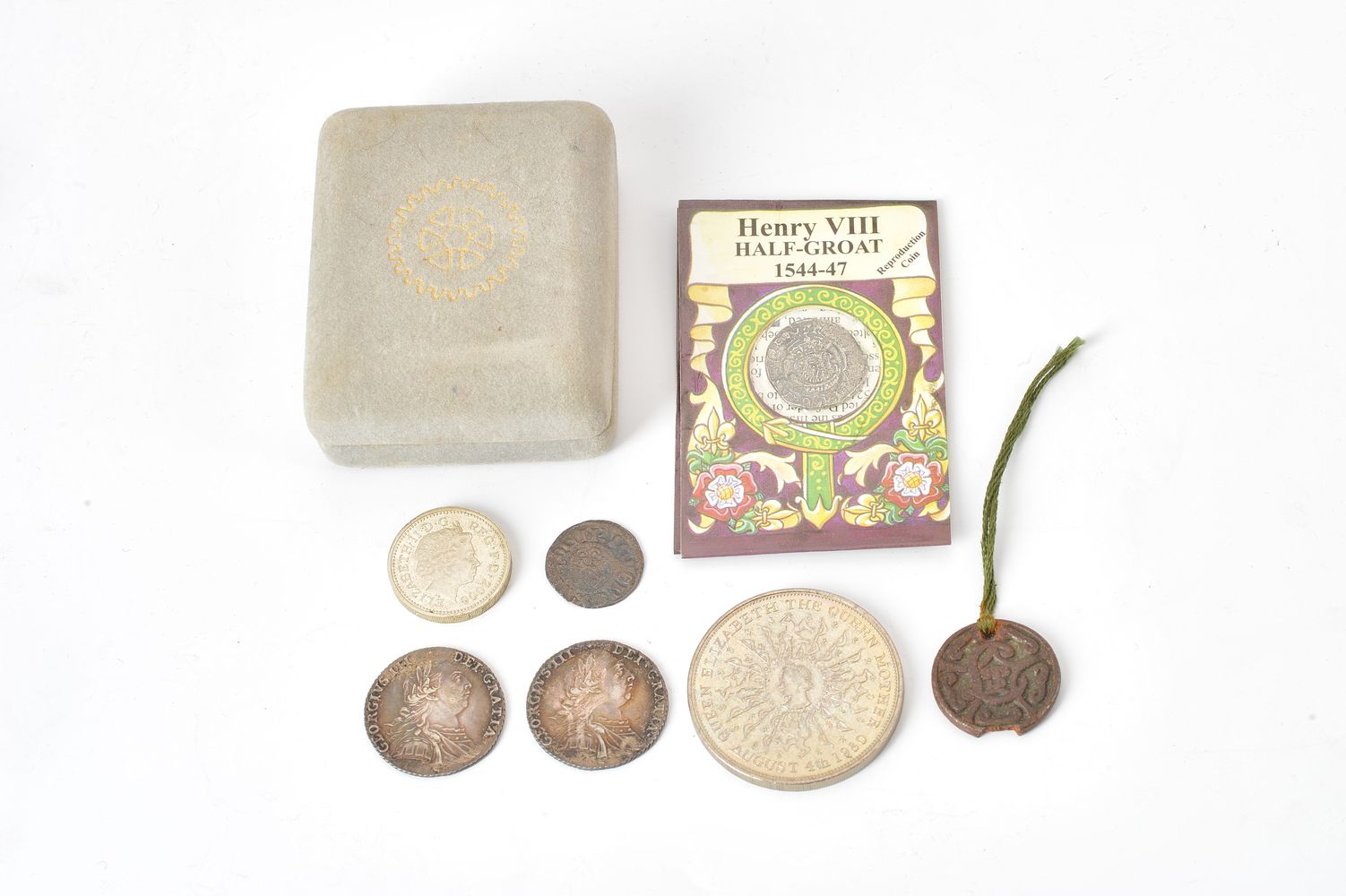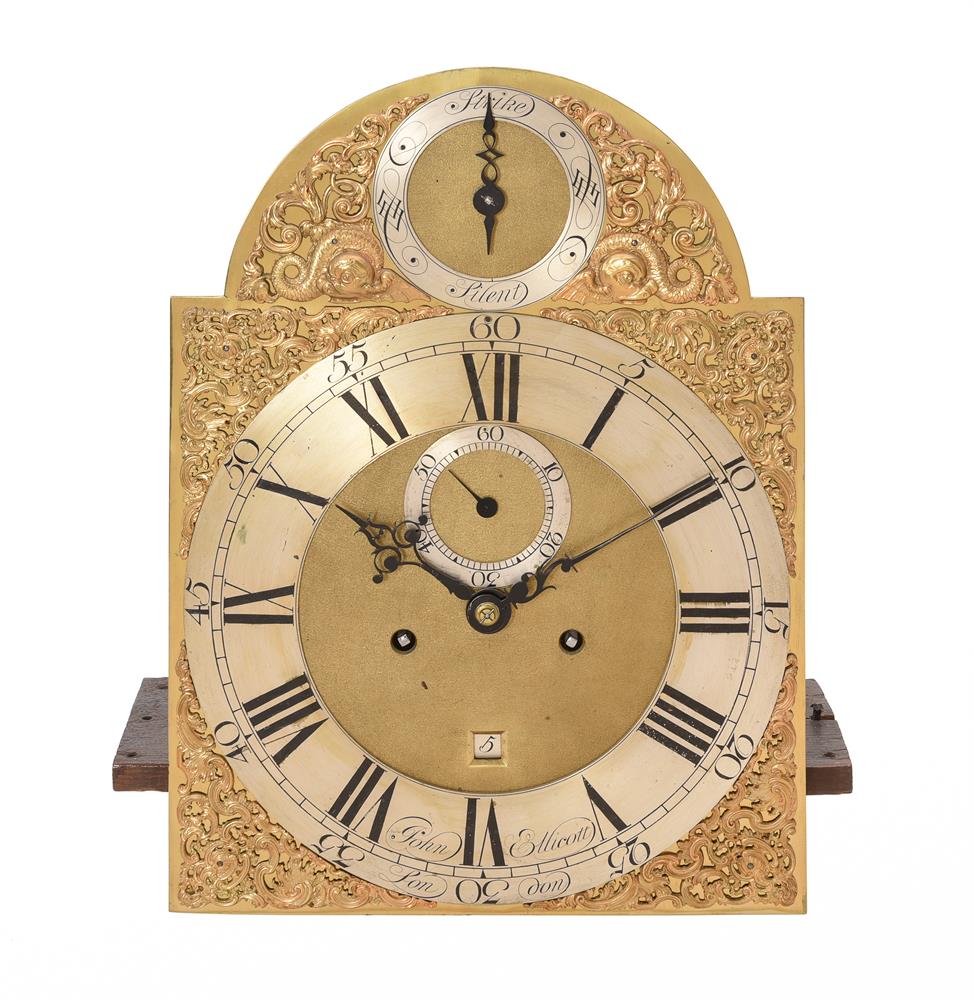A FINE GEORGE III MAHOGANY EIGHT-DAY FULL HALF-HOUR STRIKING LONGCASE CLOCK WITH TRIP-REPEATHENRY HINDLEY, YORK, CIRCA 1750-60The four double-baluster turned pillar movement with plates measuring 6.375 by 5.125 inches enclosing fine high-count wheelwork, the going train with anchor escapement regulated by brass lenticular bob seconds pendulum incorporating Hindley's cranked crutch arrangement and bolt-and-shutter maintaining power, the strike train with inside rack for sounding the hour at the hour and then again at the half hour on a second smaller bell, with Hindley's dual direction pull trip repeat lever to the backplate and cranked calendar adjustment applied to the rear of the dial plate, the 12 inch brass break-arch dial with subsidiary seconds dial to the distinctive richly matted centre within applied silvered Roman numeral chapter ring with Arabic five minutes beyond the minute track and signed Hindley, York to lower margin, with scroll-pierced blued steel hands and male mask and scroll cast spandrels to angles beneath arch centred with a calendar dial flanked by dolphin and scroll cast mounts, the case with finial blocks to the ogee-shaped domed caddy superstructure over generous architectural dentil cornice and plain frieze to lintel over rectangular door incorporating both the glazed break-arch dial aperture and the upper quadrant panels flanked by free-standing full-height slender Doric columns to front angles, the sides with arched windows and further full columns set to the rear, the trunk with cavetto throat moulding over caddy-moulded break-arch door, on plinth base with moulded skirt and squab feet.252cm (99.25ins) high including finial blocks, 58.5cm (23ins) wide, 30.5cm (12ins) deep. Henry Hindley was born in Great Harwood, near Blackburn, Lancashire 1699, little is known about his early life, however by the mid 1720's he was making clocks in Wigan where he repaired the church clock in 1726. Hindley moved with his young family (including his son, Joseph born 1728) to the prosperous city of York where, after making clocks for the Mansion House and Guildhall, he gained his Freedom of the city in 1732. Hindley s talents were such that he equipped his workshop with tools of his own design including an important dividing and wheel cutting engine, a screw cutting lathe and a fusee engine. As well as domestic clocks Hindley received commissions for several turret clocks including York Minster and supplied a range of scientific instruments including two important equatorial telescopes for the Duke of Norfolk and William Constable By the 1760 s Hindley s health had deteriorated to the extent that an ever-increasing proportion of the business was handled by his son Joseph. Henry died in 1771 with his son and successor Joseph unfortunately dying just three years later in 1774, before he had had the opportunity to stamp his own mark on the family firm. Hindley s work demonstrates a highly inventive exacting approach with each clock perhaps varying in some way to its predecessor ensuring constant refinement in design and layout. The quality of the finish of his work is generally exceptional being comparable to the very best London makers of the period which is why many collectors often refer to Hindley as the 'Tompion of the North'. The movement of the current lot is no exception being a particularly fine example of Hindley's work exhibiting inventive details such as the cranked pumping mechanism for the calendar dial, gravity fed rack striking and combined spring and stop for each of the bell hammers. The bolt-and-shutter maintaining power is beautifully executed and the trip repeat lever is ingenious in its simplicity using offset pins on a disk to ensure the lever can be tripped from by pulling from either side. The full-half hour striking of the current lot is unusual and is facilitated by having a second set of pins on the opposite side to the hammer pin wheel which are moved to act on the hammer for the second be
A FINE GEORGE III MAHOGANY EIGHT-DAY FULL HALF-HOUR STRIKING LONGCASE CLOCK WITH TRIP-REPEATHENRY HINDLEY, YORK, CIRCA 1750-60The four double-baluster turned pillar movement with plates measuring 6.375 by 5.125 inches enclosing fine high-count wheelwork, the going train with anchor escapement regulated by brass lenticular bob seconds pendulum incorporating Hindley's cranked crutch arrangement and bolt-and-shutter maintaining power, the strike train with inside rack for sounding the hour at the hour and then again at the half hour on a second smaller bell, with Hindley's dual direction pull trip repeat lever to the backplate and cranked calendar adjustment applied to the rear of the dial plate, the 12 inch brass break-arch dial with subsidiary seconds dial to the distinctive richly matted centre within applied silvered Roman numeral chapter ring with Arabic five minutes beyond the minute track and signed Hindley, York to lower margin, with scroll-pierced blued steel hands and male mask and scroll cast spandrels to angles beneath arch centred with a calendar dial flanked by dolphin and scroll cast mounts, the case with finial blocks to the ogee-shaped domed caddy superstructure over generous architectural dentil cornice and plain frieze to lintel over rectangular door incorporating both the glazed break-arch dial aperture and the upper quadrant panels flanked by free-standing full-height slender Doric columns to front angles, the sides with arched windows and further full columns set to the rear, the trunk with cavetto throat moulding over caddy-moulded break-arch door, on plinth base with moulded skirt and squab feet.252cm (99.25ins) high including finial blocks, 58.5cm (23ins) wide, 30.5cm (12ins) deep. Henry Hindley was born in Great Harwood, near Blackburn, Lancashire 1699, little is known about his early life, however by the mid 1720's he was making clocks in Wigan where he repaired the church clock in 1726. Hindley moved with his young family (including his son, Joseph born 1728) to the prosperous city of York where, after making clocks for the Mansion House and Guildhall, he gained his Freedom of the city in 1732. Hindley s talents were such that he equipped his workshop with tools of his own design including an important dividing and wheel cutting engine, a screw cutting lathe and a fusee engine. As well as domestic clocks Hindley received commissions for several turret clocks including York Minster and supplied a range of scientific instruments including two important equatorial telescopes for the Duke of Norfolk and William Constable By the 1760 s Hindley s health had deteriorated to the extent that an ever-increasing proportion of the business was handled by his son Joseph. Henry died in 1771 with his son and successor Joseph unfortunately dying just three years later in 1774, before he had had the opportunity to stamp his own mark on the family firm. Hindley s work demonstrates a highly inventive exacting approach with each clock perhaps varying in some way to its predecessor ensuring constant refinement in design and layout. The quality of the finish of his work is generally exceptional being comparable to the very best London makers of the period which is why many collectors often refer to Hindley as the 'Tompion of the North'. The movement of the current lot is no exception being a particularly fine example of Hindley's work exhibiting inventive details such as the cranked pumping mechanism for the calendar dial, gravity fed rack striking and combined spring and stop for each of the bell hammers. The bolt-and-shutter maintaining power is beautifully executed and the trip repeat lever is ingenious in its simplicity using offset pins on a disk to ensure the lever can be tripped from by pulling from either side. The full-half hour striking of the current lot is unusual and is facilitated by having a second set of pins on the opposite side to the hammer pin wheel which are moved to act on the hammer for the second be















Try LotSearch and its premium features for 7 days - without any costs!
Be notified automatically about new items in upcoming auctions.
Create an alert